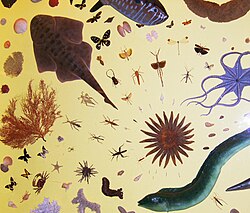
Back التناظر في علم الأحياء Arabic প্রতিসাম্য (জীববিজ্ঞান) Bengali/Bangla Ακτινωτή συμμετρία Greek Simetría bilateral Spanish Sümmeetria (bioloogia) Estonian تقارن در زیستشناسی Persian Simetría bilateral Galician סימטריה דו-צדדית HE जीवविज्ञान में सममिति Hindi Simetri bilateral HT


Symmetry in biology refers to the symmetry observed in organisms, including plants, animals, fungi, and bacteria. External symmetry can be easily seen by just looking at an organism. For example, the face of a human being has a plane of symmetry down its centre, or a pine cone displays a clear symmetrical spiral pattern. Internal features can also show symmetry, for example the tubes in the human body (responsible for transporting gases, nutrients, and waste products) which are cylindrical and have several planes of symmetry.
Biological symmetry can be thought of as a balanced distribution of duplicate body parts or shapes within the body of an organism. Importantly, unlike in mathematics, symmetry in biology is always approximate. For example, plant leaves – while considered symmetrical – rarely match up exactly when folded in half. Symmetry is one class of patterns in nature whereby there is near-repetition of the pattern element, either by reflection or rotation.
While sponges and placozoans represent two groups of animals which do not show any symmetry (i.e. are asymmetrical), the body plans of most multicellular organisms exhibit, and are defined by, some form of symmetry. There are only a few types of symmetry which are possible in body plans. These are radial (cylindrical), bilateral, biradial and spherical symmetry.[1] While the classification of viruses as an "organism" remains controversial, viruses also contain icosahedral symmetry.
The importance of symmetry is illustrated by the fact that groups of animals have traditionally been defined by this feature in taxonomic groupings. The Radiata, animals with radial symmetry, formed one of the four branches of Georges Cuvier's classification of the animal kingdom.[2][3][4] Meanwhile, Bilateria is a taxonomic grouping still used today to represent organisms with embryonic bilateral symmetry.
- ^ Holló, Gábor (2015). "A new paradigm for animal symmetry". Interface Focus. 5 (6): 20150032. doi:10.1098/rsfs.2015.0032. PMC 4633854. PMID 26640644.
- ^ McBirney, Alexander (2009). Georges Cuvier. In: The Philosophy of Zoology Before Darwin. Springer, Dordrecht. pp. 87–98.
- ^ Waggoner, Ben M. "Georges Cuvier (1769–1832)". UCMP Berkeley. Retrieved 8 March 2018.
Cuvier's insistence on the functional integration of organisms led him to classify animals into four "branches," or embranchements: Vertebrata, Articulata (arthropods and segmented worms), Mollusca (which at the time meant all other soft, bilaterally symmetrical invertebrates), and Radiata (cnidarians and echinoderms).
- ^ Cuvier, Georges; Griffith, Edward; Pidgeon, Edward (1834). The Mollusca and Radiata: Arranged by the Baron Cuvier, with Supplementary Additions to Each Order. Whittaker and Company. pp. 435–.
© MMXXIII Rich X Search. We shall prevail. All rights reserved. Rich X Search